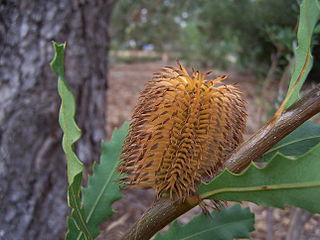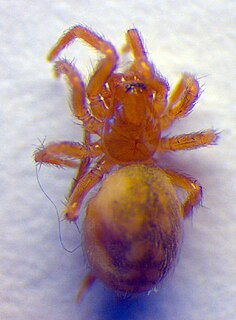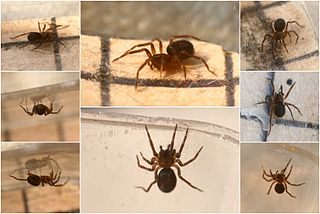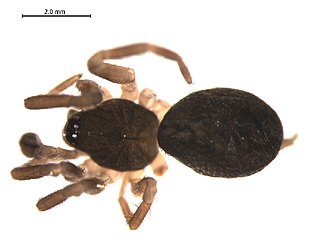Hahnia is a poorly known genus of meat-eating stem-mammals (therapsids) that lived during the Upper Triassic in Europe. This genus is based on tiny, isolated teeth, and its affinities with other cynodonts are unclear. The generic name is invalid, thus the inverted commas. The name Hahnia has already been used for a spider. The authors are aware of this, and will doubtless come up with a new name sometime in the future.

Carl Wilhelm Hahn was a German zoologist and author of the first German monograph on spiders. C. W. Hahn was an all-round natural scientist – not at all unusual for his time. Surprisingly, he seems to have been almost forgotten. Even the few biographical dates that have been published in secondary literature are not always correct as clarified by P. Sacher in his "attempt at a Biography".

Dwarf sheet spiders (Hahniidae) is a family of araneomorph spiders, first described by Philipp Bertkau in 1878. Their bodies are about 2 millimetres (0.079 in) long, and they build extremely delicate webs in the form of a sheet. Unlike many spiders the web does not lead to a retreat. The silk used in these webs is so fine that they are difficult to spot unless they are coated with dew. They greatly favor locations near water or near moss, and are often found in leaf litter and detritus or on the leaves of shrubs and trees.

Sarracenia oreophila, also known as the green pitcherplant, is a carnivorous plant in the genus Sarracenia. It has highly modified leaves in the form of pitchers that act as pitfall traps for prey. The narrow pitcher leaves are tapered tubes that rise up to 75 centimetres from the ground, with a mouth 6 to 10 centimetres in circumference Like all the Sarracenia, it is native to the New World. Sarracenia oreophila is the most endangered of all Sarracenia species, its range limited to a handful of sites in northern Alabama, North Carolina, Georgia, and—historically--Tennessee.

Banksia oreophila, commonly known as the western mountain banksia or mountain banksia, is a species of shrub that is endemic to the south-west of Western Australia. It has glabrous stems, wedge-shaped or narrow egg-shaped leaves with the narrower end towards the base, cylindrical spikes of pale pink to mauve flowers and later, up to twenty follicles in each spike, surrounded by the remains of the flowers. It occurs on slopes and hilltops in the Stirling and Barren Ranges.

Cytaea is a genus of spiders in the family Salticidae.

Banksia ser. Quercinae is a valid botanic name for a series of Banksia. First published by Carl Meissner in 1856, the name has had three circumscriptions.
Dypsis oreophila is a species of flowering plant in the family Arecaceae. It is found only in Madagascar. It is threatened by habitat loss.

Adenanthos oreophilus, commonly known as woollybush, is a species of tall shrub endemic to southwest Western Australia. It is closely related to the better known A. sericeus, and was only classified as a species distinct from the latter in 1978 by Irish botanist E. Charles Nelson.
Rosieria is an extinct genus of dwarf cynodonts from the Late Triassic of France. It belongs to the family Traversodontidae, a herbivorous group known mainly from Gondwana. The type species R. delsatei was named in 1997 on the basis of a few isolated postcanine teeth found in Saint-Nicolas-de-Port in northeastern France. These teeth were found alongside the teeth of many other cynodonts, including those of Hahnia, Gaumia, and Maubeugia. The small size of the teeth in Saint-Nicolas-de-Port suggest R. delsatei and other species were dwarf cynodonts. Most teeth in the locality belong to insectivores like dromatheriids, while those of R. delsatei and other herbivorous cynodonts are very rare.

Hahnia is a genus of dwarf sheet spiders that was first described by C. L. Koch in 1841.
Hahnia pusio, is a species of spider of the genus Hahnia. It is endemic to Sri Lanka.
Enoplognatha oreophila, is a species of spider of the genus Enoplognatha. It is endemic to Sri Lanka.

Iberina montana, the common combtailed spider, which was formerly better known as Hahnia montana, is a species of dwarf sheet spider, family Hahniidae, which is found mainly in Europe.
Pterostylis oreophila, commonly known as the Kiandra greenhood or blue-tongued greenhood is a species of orchid endemic to south-eastern Australia. Flowering and non-flowering plants have three to five dark green, fleshy leaves and flowering plants have a single green and white, sickle-shaped flower with a deeply notched, bulging sinus between the lateral sepals.

Hahnia cinerea is a species of true spider in the family Hahniidae. It is found in North America.

Hahnia glacialis is a species of true spider in the family Hahniidae. It is found in Russia (Sibiria) and North America.










